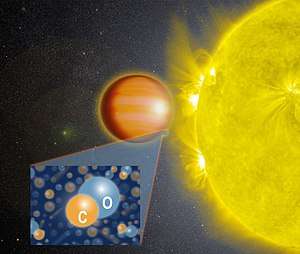WASP-18b
| Exoplanet | List of exoplanets | |
|---|---|---|
 | ||
| Parent star | ||
| Star | WASP-18 | |
| Constellation | Phoenix[1] | |
| Right ascension | (α) | 01h 37m 25.0335s[2] |
| Declination | (δ) | −45° 40′ 40.377″[2] |
| Apparent magnitude | (mV) | 9.29[1] |
| Distance | 404±1[2] ly (123.9±0.4[2] pc) | |
| Spectral type | F6[3] | |
| Mass | (m) | 1.25[4] M☉ |
| Orbital elements | ||
| Semi-major axis | (a) | 0.02026 ± 0.00068[3] AU |
| Periastron | (q) | 0.02007 AU |
| Apastron | (Q) | 0.02045 AU |
| Eccentricity | (e) | 0.0092 ± 0.0028[3] |
| Orbital period | (P) | 0.94145455+0.00000087 −0.00000132[5] d |
| (22.59487 h) | ||
| Inclination | (i) | 86 ± 2.5[3]° |
| Argument of periastron |
(ω) | 96 ± 10[3]° |
| Time of transit | (Tt) | 2448436.2359+0.0125 −0.0082[5] JD |
| Physical characteristics | ||
| Mass | (m) | 10.3 ± 0.69[3] MJ |
| Radius | (r) | 1.106+0.072 −0.054[3] RJ |
| Discovery information | ||
| Discovery date | August 27, 2009[6] | |
| Discoverer(s) | Hellier et al. (SuperWASP)[6] | |
| Discovery method | Transit[6] (including secondary eclipses) | |
| Other detection methods | Radial velocity | |
| Discovery status | Published[6] | |
| Other designations | ||
HD 10069 b, HIP 7562 b | ||
| Database references | ||
| Extrasolar Planets Encyclopaedia | data | |
| SIMBAD | data | |
| Exoplanet Archive | data | |
| Open Exoplanet Catalogue | data | |
WASP-18b is an extrasolar planet that is notable for having an orbital period of less than one day. It has a mass equal to 10 Jupiter masses,[6] just below the boundary line between planets and brown dwarfs, about 13 Jupiter masses. Due to tidal deceleration, it is expected to spiral towards and eventually merge with its host star, WASP-18, in less than a million years.[6] The planet is approximately 3.1 million kilometres (1.9 million miles) from its star, which is about 410 light-years from Earth. It was discovered by a team led by Coel Hellier, a professor of astrophysics at Keele University in England.[6]
Scientists at Keele and at the University of Maryland are working to understand whether the discovery of this planet so shortly before its expected demise (with less than 0.1% of its lifetime remaining) was fortuitous, or whether tidal dissipation by WASP-18 is actually much less efficient than astrophysicists typically assume.[6][7] Observations made over the next decade should yield a measurement of the rate at which WASP-18b's orbit is decaying.[8]
The closest example of a similar situation in the Solar System is Mars' moon Phobos. Phobos orbits Mars at a distance of only about 9,000 km (5,600 mi), 40 times closer than the Moon is to the Earth,[9] and is expected to be destroyed in about eleven million years.[10]

See also
References
- 1 2 "WASP-18b". Exoplanet Transit Database. Retrieved 2009-08-29.
- 1 2 3 4 Brown, A. G. A.; et al. (Gaia collaboration) (August 2018). "Gaia Data Release 2: Summary of the contents and survey properties". Astronomy & Astrophysics. 616. A1. arXiv:1804.09365. Bibcode:2018A&A...616A...1G. doi:10.1051/0004-6361/201833051. Gaia DR2 record for this source at VizieR.
- 1 2 3 4 5 6 7 "Notes for planet WASP-18b". The Extrasolar Planets Encyclopaedia. Retrieved 2009-09-15.
- ↑ PlanetQuest: WASP-18 b
- 1 2 McDonald, I.; Kerins, E. (2018). "Pre-discovery transits of the exoplanets WASP-18b and WASP-33b from Hipparcos". Monthly Notices of the Royal Astronomical Society: Letters. 477 (1): L21–L24. arXiv:1803.06187. Bibcode:2018MNRAS.477L..21M. doi:10.1093/mnrasl/sly045.
- 1 2 3 4 5 6 7 8 Hellier, Coel; et al. (2009). "An orbital period of 0.94days for the hot-Jupiter planet WASP-18b" (PDF). Nature. 460 (7259): 1098–1100. Bibcode:2009Natur.460.1098H. doi:10.1038/nature08245. PMID 19713926.
- ↑ Hamilton, Douglas P. (2009-08-27). "Extrasolar planets: Secrets that only tides will tell". Nature. Nature Publishing Group. 460 (7259): 1086–1087. Bibcode:2009Natur.460.1086H. doi:10.1038/4601086a. PMID 19713920. Retrieved 2009-08-28.
- ↑ Thompson, Andrea (2009-08-26). "Newfound Planet Might Be Near Death". Space.Com. Imaginova. Retrieved 2009-08-28.
- ↑ Johnson, John Jr.; Astrophysicists puzzle over planet that's too close to its sun, Los Angeles Times (August 27, 2009).
- ↑ Sharma, Bijay Kumar (2008-05-10). "Theoretical Formulation of the Phobos, moon of Mars, rate of altitudinal loss". arXiv:0805.1454 [astro-ph].
- ↑ Landau, Elizabeth; Zubritsky, Elizabeth (29 November 2017). "Exoplanet Has Smothering Stratosphere Without Water". NASA. Retrieved 29 November 2017.
External links
| Wikinews has related news: Extrasolar planet may eventually collide into its star |
![]()